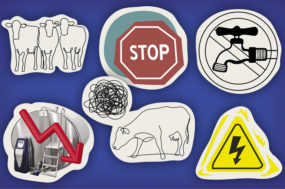“Graduate Student Literature Review: Udder edema in dairy cattle – A possible emerging animal welfare issue.” Journal of Dairy Science Vol. 104 No. 6, 2021. This literature review article, from Colorado State University, describes udder edema in dairy cattle and the factors that may cause it.
Udder edema is a noninfectious metabolic disorder. The authors summarize the factors associated with udder edema as genetics, nutrition, oxidative stress and physiological changes in freshening heifers. They also refer that udder edema negatively affects the productive life of a dairy cow, namely udder support structures may be broken down due to tissue damage, and swollen teats may become sensitive, which makes attaching the milking unit more difficult.
The amount of milk produced is decreased due to fluid buildup in the tissue spaces. Risk of secondary diseases, such as mastitis or udder cleft dermatitis, is also increased. Cows also exhibit negative behaviours, similar to those observed in mastitis cases, such as decreased lying time and frequent stepping in the parlour. All these factors have an economic impact on the profitability of the farm.
Research indicates that udder edema is common in dairy cows, with 66% of cows having udder edema at least once. The authors say that recent research investigating the welfare of animals with udder edema is sparse, and validated measuring methods for accurately assessing the severity of udder edema are also lacking. Their interest for this problem is its connection with animal welfare, since udder edema can cause pain. They say that dairy cows with udder edema need to be objectively evaluated for pain. Milking becomes an unpleasant experience for both human and cow, further resulting in potential injury, infection or early culling, greatly affecting the profitability and well-being of that animal.
Udder edema manifests as an accumulation of lymphatic fluid in and around the interstitial spaces of the mammary gland. During pregnancy, the increase of fetal pressure in the pelvic area causes blood and lymphatic fluid circulation to be impaired, resulting in fluid buildup in the udder tissues. Udder edema is designated a metabolic disorder and, based on several articles on the subject, has been associated with excessive salt in the diet, greater age at first calving, above-ideal body condition score (BCS), genetic traits, physiological changes during maturation and udder development, oxidative stress, increased stress from pen movements when taking out or bringing in new animals to the group, overcrowding and heat stress. A study found that heifers calving in winter were 3.68 times more likely to develop udder edema than in summer. Sites of fluid accumulation include the brisket, udder, navel and, in extreme cases, the legs and vulva. Edema became less severe and decreased in prevalence as animals increased in parity.
The review addresses multiple factors that contribute to udder edema and secondary risks associated with udder edema. Aspects like improper or lack of supplementation of protein, anionic salts and minerals increases the risk of udder edema. The authors say that udder edema can be reduced on a short-time basis by adjusting nutrition and, on a long-term basis, possibly by shifting genetic selection parameters.
“Bodyweight of dairy heifers is positively associated with reproduction and stayability.” Journal of Dairy Science Vol. 103 No. 5, 2020.
This study, originating from New Zealand, investigated the relationships between bodyweight and stayability on the farm, and bodyweight and calving pattern of New Zealand dairy heifers. This is interesting since several researchers mention the importance of dairy producers to record the weight and average daily gain (ADG) of their heifers, but we rarely see studies making use of that information. They worked with five different breed groups: Holstein-Friesian, Holstein-Friesian crossbred, Jersey, Jersey crossbred and Holstein-Friesian × Jersey crossbred. Based on bodyweight at 6, 12 and 15 months old, they analyzed their relationship with stayability, calving rate and re-calving rate over the first three calvings.
The authors refer that herds that have greater cow survival rates have a greater proportion of mature, high-producing cows and a lower proportion of replacement heifers needing to be reared, compared with herds that have low cow survival rates. For this study, they used stayability as a measure of cow survival.
Stayability does not require recording of cull data, since stayability is defined as the probability of an animal surviving to a specific age, given that they had the opportunity to reach that age. The authors, referring to another study done in New Zealand, say that heritability of heifer survival is low, which suggests that environmental factors influence heifers’ survival to 25 months old to a greater extent than genetics.
Other studies showed that a greater number of heaviest Holstein-Friesian heifers (343 kilograms or more at breeding) were present at the beginning of first (93% versus 82%) and second (76% versus 62%) lactations compared with the lightest (290 kilograms or less) heifers, emphasizing the survival benefits of having Holstein-Friesian heifers heavier at breeding.
The authors used bodyweight records of 189,936 spring-born New Zealand dairy heifers, born between 2006 and 2013 spring-calving dairy seasons. Approximately 92% of the heifers that were reared calved for the first time as 2-year-olds, 76% a second time as 3-year-olds and 61% a third time as 4-year-olds. The study discovered a positive curvilinear relationship between pre-breeding bodyweight and stayability, as well as reproductive parameters of dairy heifers. Heifers that were heavier at 6, 12 and 15 months old were more likely to remain in the herd for first, second and third calving, and were more likely to calve early for first calving compared with heifers that were lighter, regardless of breed group.
For heifers at the heaviest end of the bodyweight range in the current study, the authors found a slight decline in stayability and reproductive performance compared with heifers in the mid-range of bodyweight. Consequently, they conclude, for heifers that were above average in bodyweight, the benefit of increasing bodyweight before first breeding would be small and could even result in a slight decline in stayability. For heifers that were below average in bodyweight, considerable benefits for stayability and reproductive performance could be achieved by improving rearing practices to result in heavier heifers throughout the pre-breeding rearing phase.
This column brings you information regarding some of the research being done around the world and published in the Journal of Dairy Science. The objective is to bring to light areas of research that may have an immediate practical application on a dairy farm, as well as research that, even though it may not have a practical impact now, could be interesting for its future potential application. The idea is to give a brief overview of select research studies but not go into detail on each topic. Those interested in further in-depth reading can use the citations to find each study.









